
Education - General: early private schools
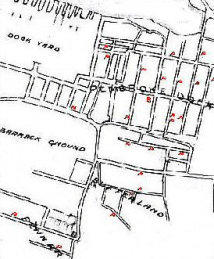
Pembroke Dock, c. 1860. Small Private
institutions outnumber the new
National and British schools.
National educational policies meant that, by the twentieth century, schools stood alongside churches
and chapels as focal points of community life. Previously optional and fee-paying, education became
universal and mostly free
Sunday schools and small private day schools provided basic education until the 1840s. The quality of
the day schools varied in 1846: Mr Hitchin's was "in a very dirty room". During the inspector's visit Mr
Hitchin "made great exertions to keep his scholars quiet and silent ... but they cared little for him".
Despite this, they had some grasp of scripture, geography and arithmetic.
Mr Barclay fared better. His twenty pupils were satisfactory in scripture, arithmetic, geography,
geometry, history, astronomy and navigation, but here too "the manners of the lads were rather rude,
and they amused themselves in mimicking their master". Mrs Peters recalls Barclay, who was also a
pharmacist, as "a man of scientific and advanced ideas". When even gas light was a novelty, "he had a
galvanic battery which he used occasionally to allow the boys to try. He oftentimes talked to them
about electricity". Mr Barclay also offered night classes for twelve adults who wished to improve their
skills in "RWA" - reading, writing and arithmetic.
(Sources: Reports ... Commissioners 466-472, 492; Peters 108; Rose, R. 195-6)
Picture by courtesy of Pembrokeshire Record Office.

Education - The National & British Schools
Two rather more methodical elementary schools - the National and British - were built in the 1840s. As elsewhere, the National School was linked with the
Church of England, while chapel-going parents favoured the British School . There was some government subsidy to the National and British societies. These
schools were also financed through fees ("one penny per week" in the National School in 1846) and fundraising. School projects aroused the same enthusiasm
as chapel-building ones. For the British school, "dockyardmen did all the labour on the woodwork free". Both ran money-generating concerts and bazaars,
timed to coincide with the holiday atmosphere of ship launchings.
Teaching in both schools featured delegation: some of the instruction would be first given by the master or mistress to monitors and pupil-teachers. They, in
turn, would then teach and supervise the younger pupils. Mr John Adams, master at the British School, encouraged the employment of more advanced "pupil
teachers" for subtler instruction.
Inspectors praised both schools. Matthew Arnold thought the boys' section of the British School "the best ... I have met with in South Wales" and John Adams "a
thoroughly effective master".
Supporters of the two schools were sometimes less flattering about each other, when church-chapel rivalry spilled over into educational debate. Terms such as
"numbskull" and "steeped in the grossest bigotry" graced letters in local papers.
The British and National schools were incorporated into the later system
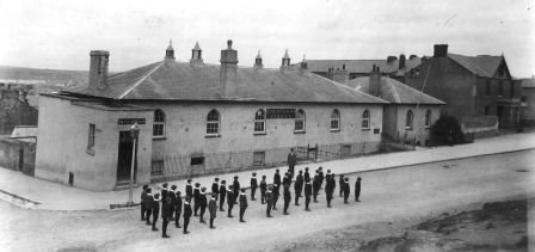
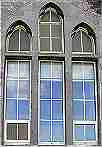


Victorian architects emphasised that new schools were
continuing the educational work of Sunday schools and
churches. "Victorian gothic" windows in the National
School (left) and Albion Square Board School (centre)
repeat the shape of a genuine mediaeval church
window - St Mary's, Pembroke (right).

Sources Peters 111 Mason 134 Marsden 13-23 Seaborne 126-7 Reports Commissioners 468) Photographs by Mrs Gwen Griffiths.
The Mechanics' Institute in Dimond Street functioned as an early cultural and further education
centre for adults and young people. It was part of a nationwide movement. The Institute operated in
the 1850s in a Lewis Street house. In 1862, the new building was completed on land in Dimond
Street, given at a nominal rent by Sir Thomas Meyrick. Like other some other early community
buildings, it was paid for by subscriptions, fundraising events, and membership fees.
In 1875, we learn, "The Mechanics' Institute ... possesses a reading room ... with all the daily and
weekly newspapers, periodicals, etc. and is open from 9am to 10pm. The library contains 3,500
volumes. There is a small museum in connection with it ... members pay sixpence per month". A
splendid billiards room was added, and evening classes were available here in the 1890s.
A key figure in the Institute was "Mr Thomas Dunbar Harries, the respected and able Librarian". Mr
Harries's first career was as in the Dockyard. He went on to serve as librarian for 32 years, being
rewarded on his retirement in 1882 with an illuminated scroll and a purse of gold.
This building has now been converted in to flats on the upper floors with retail units at ground level
(AJ Edit (2018)
(Sources: Findlay 21, 34; 1851 census index; Peters 63-4)
Education - Board and elementary schools
I AM OLD NOW.
I am an old dog now, and not much use; but still my master is very kind to
me ..."
- page heading from a reading book
used at ...
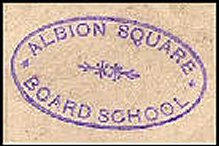
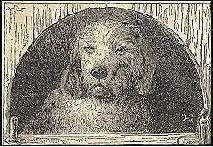
The 1870 Education Act sought to provide "board schools" for those children not already attending school. "Boards" were elected committees, whose duties
included levying rates to help pay running costs. Different interest groups would jostle for influence at elections - dockyarders versus others, churchgoers versus
chapel goers. The local board established three schools in Pembroke Dock - Pennar (1874), Albion Square (1877, extended 1896) and Llanion (1892).
These board schools offered general education to younger children. Albion Square in the 1890s also offered "higher grade" studies in mathematics, chemistry,
agriculture, French, shorthand, book-keeping, magnetism and mechanics.
The 1902 Education Act passed responsibility for schools to local authorities - Borough and County education committees. By now, resources allowed instruction
by certificated teachers.
The new Coronation school was completed in 1904 on the site of the old British School. Mrs Peters describes the opening festivities: "the children of the various
schools, wearing distinctive ribbons, assembled in Albion Square, from whence, accompanied by teachers and headed by the temperance band, they marched in
procession to Meyrick Street, where they were presented with round tins of chocolate which bore a portrait of the King".
Until 1947 these schools were responsible for the education of most children from infancy up to their early and mid teens, with boys and girls mostly taught
separately.
(Sources: Jones, Gareth 400-1; Mason 138-142; Peters 111-115) Pictures from private collection.

Education - Dockyard & Intermediate schools

Dockyard apprenticeships were highly sought after. Evening lessons and the Dockyard class in Albion Square
prepared pupils for the entrance examination. Mr Billy Nicholas recalls part of the syllabus for fifteen year-olds
around 1905: "recurring decimals, simple and compound proportion, time and work, distance time and rate, tide
and stream problems; chain rule, simple and compound interest, square and cube root, duodecimals (area and
volume)".
Those accepted as apprentices continued with similarly demanding part time study at the Royal Dockyard School.
The school's roll of honour (1842-1919) was in the Pater Hall it’s new home is likely to be the Heritage Centre
located in the Garrison Chapel (update August 2018 AJ) Ten ex-pupils became Chief Constructors, and two became
university professors.
Dockyard classes and the Royal Dockyard School
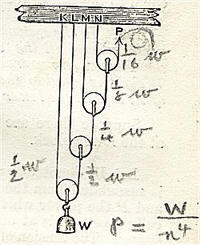
Illustration from Royal Dockyard
School textbook, with pupil's
notes, 1879.
The County Intermediate School.
The County Intermediate School was established in 1895, following the County Council's policy, to
prepare pupils aged from ten to seventeen for careers such as commerce, "agriculture, civil service,
engineer studentship ... teaching, banking", or for further study.
At a time when continental education was regarded as a model, the new headmaster's credentials
were impressive. Mr T.R. Dawes (MA London) had studied at the universities of Bonn and Paris, and
written a study of bilingual teaching in Belgium.
Despite "meetings ... subscriptions, concerts [and] bazaars" new buildings could not be provided
straightaway, so from 1895 Mr Dawes and his staff taught in the Victoria Hotel assembly rooms. In 1899 the new school was ready at the top of Argyle Street. Its
science laboratories were to arouse particular interest.
In 1947 the County Intermediate became Pembroke Grammar School.
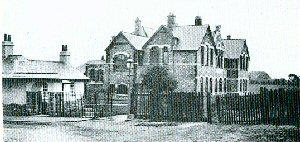
(Sources: Nicholas; Dawes; Mason 146-7; Peters 113-4)
Pictures by courtesy of: Dockyard School roll of honour, Pembroke Dock Town Council (photograph, Mrs Gwen Griffiths) - textbook, Pembroke Dock Museum Trust - County School, Mr Phil
Carradice.

Education - Albion Square School logbook
Mr John Hogg's notes on Albion Square logbook, 1878-1957, outline a century of teachers' concerns. Pupils are
absent because of fairs, blackberrying, storms and illness such as measles, smallpox and diphtheria. In 1922,
the school closes for one month due to whooping cough and influenza. Half holidays are granted for ship
launchings, regattas, and air days. With mass unemployment after 1926, "boot fund" collections start - in
January 1937, children whose parents are out of work "have not the boots or clothing to face this weather".
In World War II, air raids disrupt school life. One morning, "Miss Davies is absent suffering from shock following
the destruction of her home". American soldiers send the children gifts of sweets, and wardens check the pupils'
gas masks. In 1957, electric lighting replaces gas lamps .
(Sources: Hogg, Lost PD)
Picture by Mrs Gwen Griffiths.


Education - Grammar, Secondary Modern & Comprehensive schools
The County Intermediate became Pembroke Grammar School around 1947,
while the Coronation became the secondary modern school. Children under 11
now attended primary schools at Pennar, Albion square and Llanion.
The grammar school moved to new premises at Bush in 1955, and the
Coronation expanded to Argyle Street. Bush House, which had been home to
the Meyrick family, now housed boarders studying agriculture. The grammar
and secondary modern schools merged into Bush Comprehensive School in
1973
(Sources: Carradice 108)
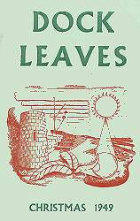
Dock Leaves, in the 1950s, was a
magazine of poetry and the arts. The
first editor was Raymond Garlick,
English master at Pembroke Grammar
School. It continued as The Anglo
Welsh Review, edited by headmaster
Roland Mathias. Kenneth Cooper, the
art master, designed and drew the
first issue's cover illustration

Education - New and old
The town's first denominational school in modern times, St. Mary's Roman Catholic School, was established in 1959. An even newer development is
Pembroke Dock Community School, near the memorial park, recently opened by HM the Queen.
The town's older schools mostly continue as educational or community centres. The original Pennar School is a social centre, Llanion houses a training
institute, and Albion Square is currently awaiting its take over by Pembrokeshire Collage replacing the Coronation Centre which is to close and be
converted into housing. On the site of the County School now stands the local office of Pembrokeshire County Council.

Education -
The Mechanics' Institute
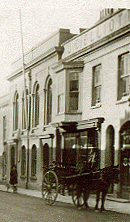
The Mechanics' Institute
(with flag-pole) has the
same rounded windows
as some chapels of its
day.
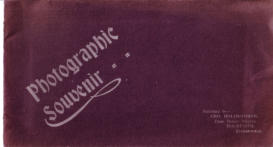
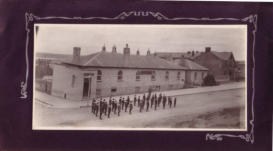
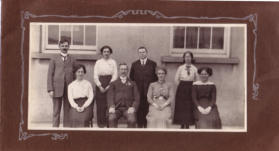
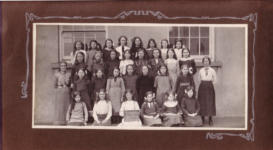
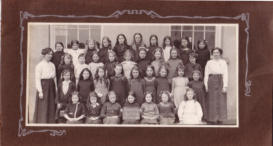
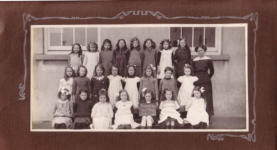
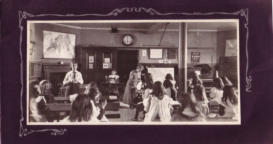

(AJ Catswebcom 2018)
TOP
HOME
My Great Grandfather used to sing:
In Albion Square there’s a school
And in that school there’s a stool
And on that stool there sits a fool
And his name is Billy Twicey.
Immortalising the school teacher William Williams in the late nineteenth century!(John Cole November 2017)
Education User Donated Information (New 2018)
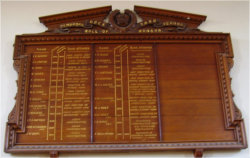
(Amendment, updates and additions) (AJ) Anndra Johnstone
This site is designed, published and hosted by CatsWebCom Community Services © 2018 part of Pembroke Dock Web Project








































